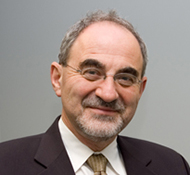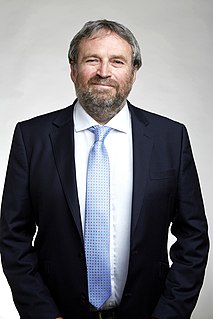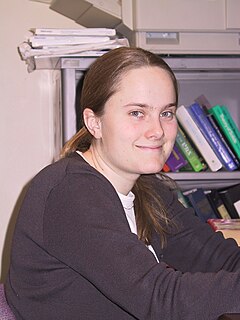Related Research Articles

A photonic crystal is a periodic optical nanostructure that affects the motion of photons in much the same way that ionic lattices affect electrons in solids. Photonic crystals occur in nature in the form of structural coloration and animal reflectors, and, in different forms, promise to be useful in a range of applications.
Sajeev John, OC, FRSC is a Professor of Physics at the University of Toronto and Canada Research Chair holder.

Eli Yablonovitch is an American physicist and engineer who, along with Sajeev John founded the field of photonic crystals in 1987. He and his team were the first to create a 3-dimensional structure that exhibited a full photonic bandgap, which has been named Yablonovite. In addition to pioneering photonic crystals, he was the first to recognize that a strained quantum-well laser has a significantly reduced threshold current compared to its unstrained counterpart. This is now employed in the majority of semiconductor lasers fabricated throughout the world. His seminal paper reporting inhibited spontaneous emission in photonic crystals is among the most highly cited papers in physics and engineering.
Federico Capasso, a prominent applied physicist, was one of the inventors of the quantum cascade laser during his work at Bell Laboratories. He is currently on the faculty of Harvard University. He has co-authored over 450 papers, edited four volumes, and holds over 60 US patents.
Philip St. John Russell, FRS, is a Director of the Max Planck Institute for the Science of Light in Erlangen, Germany. His area of research is "photonics and new materials".
Wilson Sibbett CBE FRS FRSE is a British physicist noted for his work on ultrashort pulse lasers and Streak cameras. He is the Wardlaw Professor of Physics at St Andrews University.
The International Conference on Physics of Light–Matter Coupling in Nanostructures (PLMCN) is a yearly academic conference on various topics of semiconductor science and nanophotonics.
Ann Catrina Coleman FIEEE FOSA is a Scottish electrical engineer and professor at the University of Texas at Dallas specialising in semiconductor lasers.

A photonic metamaterial (PM), also known as an optical metamaterial, is a type of electromagnetic metamaterial, that interacts with light, covering terahertz (THz), infrared (IR) or visible wavelengths. The materials employ a periodic, cellular structure.
Thomas Baer is the Executive Director of the Stanford Photonics Research Center, a consulting professor in the Applied Physics Department and an Associate Member of the Stem Cell Institute at Stanford University. His current scientific research is focused on developing imaging and biochemical analysis technology for exploring the molecular basis of human developmental biology and neuroscience. He received a B.A. in physics from Lawrence University in 1974, and a Ph.D. in atomic physics from the University of Chicago in 1979, where he studied with Professors Ugo Fano and Isaac Abella. After receiving his Ph.D. he worked with Nobel Laureate John L. Hall at JILA, University of Colorado, performing research on frequency stabilized lasers and ultra-high precision molecular spectroscopy.

Miles John Padgett is Professor of Optics in the School of Physics and Astronomy at the University of Glasgow. He has held the Kelvin Chair of Natural Philosophy since 2011 and served as Vice Principal for research at Glasgow from 2014 to 2020.

Roberto Morandotti is a physicist and full Professor, working in the Energy Materials Telecommunications Department of the Institut National de la Recherche Scientifique. The work of his team includes the areas of integrated and quantum photonics, nonlinear and singular optics, as well as terahertz photonics.

David A. B. Miller is the W. M. Keck Foundation Professor of Electrical Engineering at Stanford University, where he is also a Professor of Applied Physics by courtesy. His research interests include the use of optics in switching, interconnection, communications, computing, and sensing systems, physics and applications of quantum well optics and optoelectronics, and fundamental features and limits for optics and nanophotonics in communications and information processing.

James Scott Dunlop is a Scottish astronomer and academic. He is Professor of Extragalactic Astronomy at the Institute for Astronomy, an institute within the School of Physics and Astronomy at the University of Edinburgh.
Andrew Collier Cameron is a British astronomer specialising in the discovery and characterisation of exoplanets. He is a founding co-investigator of the WASP project and served as the head of the School of Physics and Astronomy of the University of St Andrews between 2012 and 2015 where he is currently a professor.

Prof. Ravindra Kumar Sinha was the director of the CSIR-Central Scientific Instruments Organisation (CSIR-CSIO) Sector-30C, Chandigarh-160 030, India & Professor - Applied Physics, Dean-Academic[UG] & Chief Coordinator: TIFAC-Center of Relevance and Excellence in Fiber Optics and Optical Communication, Mission REACH Program, Technology Vision-2020, Govt. of India Delhi Technological University Bawana Road, Delhi-110042, India.

David John Richardson is a Professor and Deputy Director of the Optoelectronics Research Centre at the University of Southampton.
Jonathan C. Knight, is a British physicist. He is the Pro Vice-Chancellor (Research) for the University of Bath where he has been Professor in the Department of Physics since 2000, and served as Head of Department. From 2005 to 2008, he was founding Director of the University's Centre for Photonics and Photonic Materials.

Michelle Povinelli is a Professor of Electrical Engineering and Physics and Astronomy at the University of Southern California (USC) and Fellow of the OSA and SPIE. Povinelli's research in nanophotonics focuses on the behavior of light inside complex materials.
References
- ↑ Krauss TF, DeLaRue RM, Brand S, "Two-dimensional photonic-bandgap structures operating at near infrared wavelengths" NATURE 383 pp. 699-702, 1996
- ↑ "Professor Thomas Fraser Krauss FRSE - The Royal Society of Edinburgh". The Royal Society of Edinburgh. Retrieved 12 February 2018.